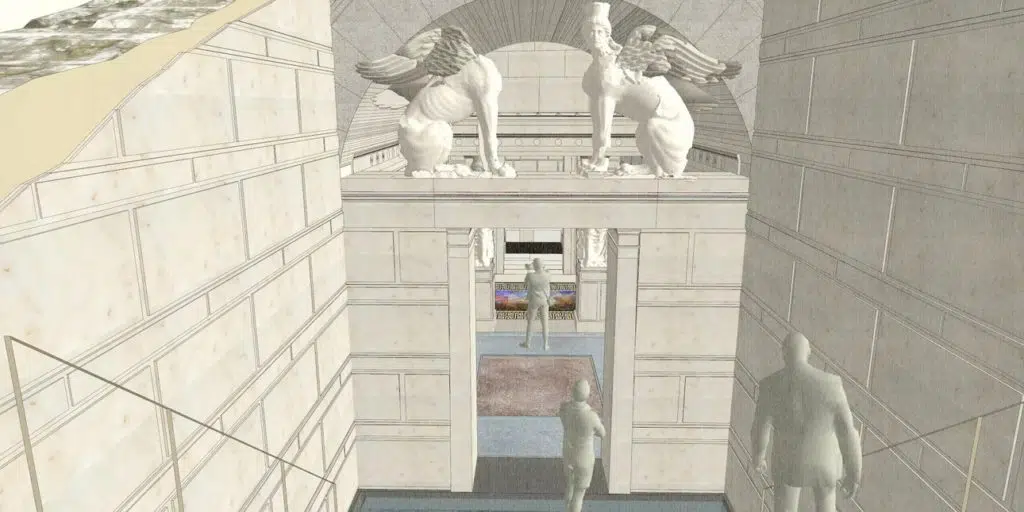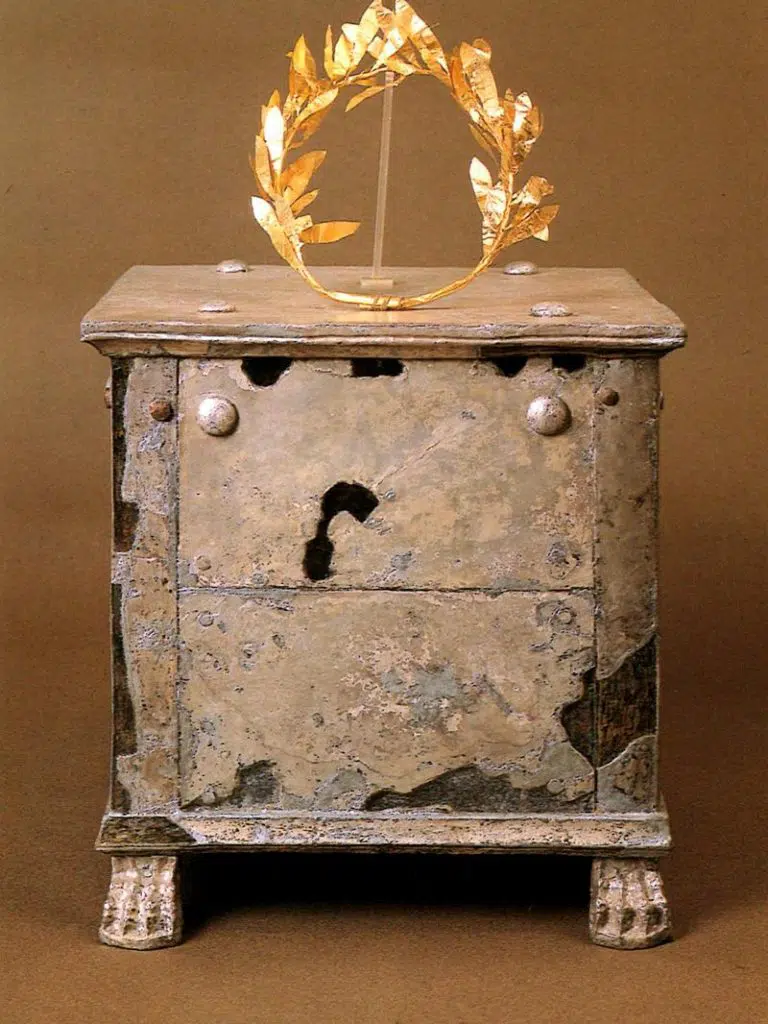
The Tomb of Amphipolis, considered to be one of the ancient Wonders of the World, will soon be rebuilt, showcasing the remnants of the original tomb by means of a glass floor.
The Greek Ministry of Culture and Sport announced on Monday that it will rebuild much of the ancient monument, at Kasta in Amphipolis, contracting an outer shell that will once again house the ancient treasures inside.
The Kasta burial mound is the site of the enormous tomb complex, atop which sat a monumental lion on a base.
Greece’s Central Archaeological Council unanimously approved the architectural preliminary design of the outer shell of space 1 – between the precinct and the first partition wall adorned with the famous sculptures of the Sphinx – in the Tomb.
As the Minister of Culture and Sports Lina Mendoni said in a statement “The works on the monument at the Kasta mound are proceeding in a systematic and methodical manner. At our last check at the monument, last June, we had announced that the above architectural studies were to be submitted for opinion to the KAS by the end of August.”
Noting that the project has experienced significant delays because of the pandemic, Mendoni added that the monument will be open to special groups beginning in 2022.

Since the original porch and roof have not been saved, the reconstruction of the outer shell of the monument aims to permanently protect the space from humidity and external weather conditions. Its walls have sensitive coatings and colors, and of course the Sphinx sculptures must be protected as well.
Soon, temperature and humidity co strolls, along with appropriate lighting and possibly even air conditioning will be added to the Tomb.
The shell “was designed to refer to the geometry and dimensions of the ancient portico, without copying it,” the Ministry stated, but it will have “completely abstract architectural features.

“The goal is its harmonious presence in the space in relation to the monumental ensemble, while serving functional needs, such as accessibility and viewing by the visitor.”
To make the site accessible for the disabled, a small elevator will be added to the site.
Inside the monument, steps will lead to a glass floor which will allow for the view of the Caryatids and the third area, which contains the famous mosaic of the “Rapture of Persephone.”
Spectacular ancient Greek mosaic of Persephone and Pluto part of Tomb of Amphipolis
A spectacular ancient Greek mosaic allegorically depicting the abduction of Persephone by Pluto is part of the Tomb — however, the personages actually shown in it are Philip and Olympias of Macedon.
In 2012, Greek archaeologists unearthed the large tomb within the Kasta Hill, the largest burial mound in Greece, indicating the great prominence of the personages who must have been buried there.
However, to this day the exact identification of this person or persons is unknown, although the ossuary for the military leader Brasidas was found there.
The perimeter wall of the tumulus is a gargantuan 497 meters (544 yards) long, constructed of limestone covered with marble.
The tomb comprises three chambers separated by walls. The famous two sphinxes are situated just outside the entrance to the tomb. Two of the columns supporting the roof in the first section are in the form of Caryatids, in the 4th century BC style. All of these statues will soon be enclosed by the new shell to be built over them.
That excavation was the first to reveal the pebble mosaic allegorically showing the abduction of Persephone by Hades, directly behind the Caryatids and in front of the Macedonian marble door leading to the “third” chamber.
Hades’ chariot is shown drawn by two white horses, led to the underworld by Hermes. Experts say that the mosaic verifies the Macedonian character of the tomb. Since the head of one of the sphinxes was found inside the tomb behind the broken door, it is clear that there were intruders and possibly looters at the site even as far back as antiquity.
Dr. Katerina Peristeri, the archaeologist heading the excavation of the tomb, dates the tomb to the late 4th century BC, the period after the death of Alexander the Great (323 BC).
As part of the restoration of the tomb and its surroundings, new stones just like the originals at the grave site — which were later repurposed by the Romans elsewhere — have been placed into their proper locations.
Amphipolis was part of the Macedonian Royal Road
Amphipolis was made a colony of Athens in 465 BC as part of the city’s ongoing efforts to consolidate its control over Thrace, which was strategically important because of its primary materials and the sea routes vital for Athens’ supply of grain from Scythia.
The city itself and its first walls date back to 437 BC, becoming the main power base of the Athenians in Thrace and, consequently, a target of choice for their Spartan adversaries. The Athenian population remained very much in the minority in the city.
This was why Amphipolis remained an independent city and an ally of the Athenians, rather than a colony or member of the Athens-led Delian League. However, in 424 BC the Spartan general Brasidas easily took control of the city.
A rescue expedition led by the Athenian general — and later historian — Thucydides, had to settle for securing Eion and could not retake Amphipolis, a failure for which Thucydides was sentenced to exile. A new Athenian force under the command of Cleon failed once more in 422 BC during the Battle of Amphipolis at which both Cleon and Brasidas lost their lives.
Brasidas, however, survived long enough to hear of the defeat of the Athenians and was buried at Amphipolis with impressive pomp. From then on he was regarded as the founder of the city and honoured with yearly games and sacrifices.
Less than a century later, Amphipolis served as the place where Alexander the Great prepared for his campaigns leading to his invasion of Asia. The port was also used as naval base during his campaigns in Asia.
Alexander’s three finest admirals, Nearchus, Androsthenes and Laomedon, resided in Amphipolis, which is also the place where, after Alexander’s death, his wife Roxana and their son Alexander IV were exiled and later murdered.
The importance of the city in this period is shown by Alexander’s decision to make it one of the six cities at which large luxurious temples costing 1,500 talents were built.
Throughout Macedonian sovereignty Amphipolis was a strong fortress of great strategic and economic importance, as shown by inscriptions. Amphipolis became one of the main stops on the Macedonian royal road and later on the Via Egnatia, the principal Roman road which crossed the southern Balkans.
After the final victory of Rome over Macedonia in the Battle of Pydna in 168 BC, Amphipolis became the capital of one of the four mini-republics, or merides, which were created by the Romans out of the kingdom of the Antigonids which succeeded Alexander’s empire in Macedon.
These merides were gradually incorporated into the Roman client state, and later province, of Thracia. According to the Acts of the Apostles, the apostles Paul and Silas passed through Amphipolis in the early AD 50s, on their journey between Philippi and Thessalonica, where they proselytized to the Greeks, including Epicurean and Stoic philosophers.
Excavations in and around Amphipolis have revealed a range of important public buildings, ancient walls and tombs. Many of the finds made in these digs are displayed at the archaeological museum of Amphipolis.
The Lion of Amphipolis monument nearby is a popular destination for visitors; discovered when soldiers were digging trenches in WWI, the monumental Lion was once thought to have been situated atop the burial mound, or tumulus, of Amphipolis but experts now do not believe this to be the case.
See all the latest news from Greece and the world at Greekreporter.com. Contact our newsroom to report an update or send your story, photos and videos. Follow GR on Google News and subscribe here to our daily email!



